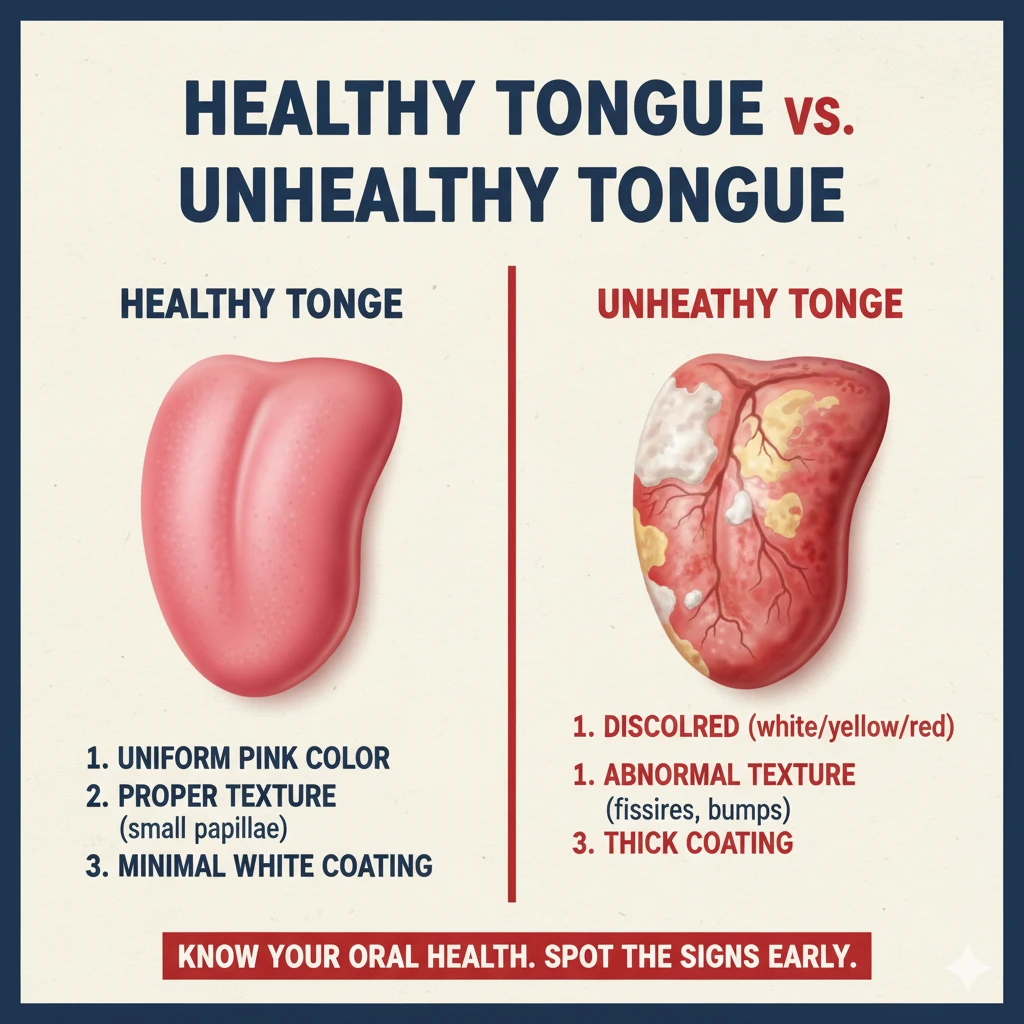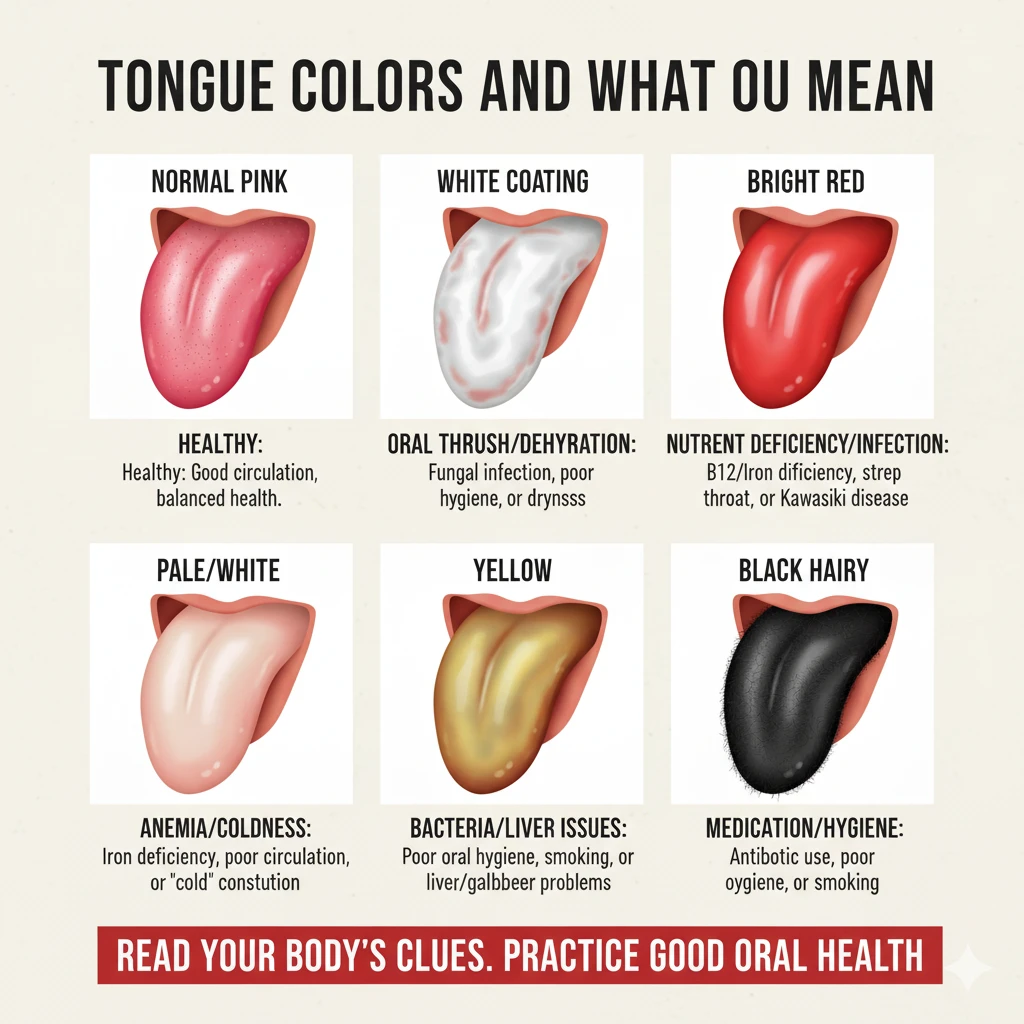Did you know your tongue can tell you a lot about your overall health? From vitamin deficiencies to infections, fungal overgrowth to circulation problems, your tongue acts like a mirror reflecting what’s happening inside your body. For thousands of years, physicians in both traditional Chinese medicine and modern Western medicine have used tongue examination as a diagnostic tool to assess a patient’s health status.
Your tongue isn’t just essential for tasting delicious food and forming words when you speak — it’s also a remarkably sensitive indicator of your nutritional status, hydration levels, digestive health, and immune function. Changes in color, texture, coating, or the appearance of unusual bumps, cracks, or sores can signal underlying health conditions long before more serious symptoms develop.
The problem is that most people never look closely at their tongue unless something feels obviously wrong. They miss subtle warning signs that could help them catch vitamin deficiencies, anemia, infections, or even more serious conditions early when they’re easiest to address.

Here’s what your tongue’s color, texture, and coating may be trying to tell you about your health.
The Role of the Tongue in Your Body
Your tongue is far more than just a muscle that helps you taste and swallow food. It’s covered with thousands of tiny bumps called papillae, which contain taste buds that allow you to detect sweet, salty, sour, bitter, and umami flavors. But beyond its sensory functions, the tongue serves as an accessible window into your body’s internal health.

Why doctors examine your tongue:
The tongue’s appearance changes in response to systemic health issues, nutritional deficiencies, infections, and organ dysfunction. Its color reflects blood circulation and oxygenation. Its coating indicates digestive health and bacterial balance. Its texture reveals vitamin and mineral status. Its moisture level signals hydration.
Because the tongue is easily accessible and highly vascular (full of blood vessels), it provides immediate visual clues about what’s happening throughout your body. Traditional Chinese medicine practitioners have mapped different tongue areas to specific organs and body systems, while modern medicine uses tongue examination to diagnose anemia, vitamin deficiencies, infections, and inflammatory conditions.
What a Healthy Tongue Looks Like
Before identifying warning signs, it’s important to know what normal looks like. A healthy tongue typically has these characteristics:
Color: Light to medium pink — the exact shade varies slightly from person to person, but it should have consistent color throughout.
Texture: Slightly bumpy with small, visible papillae (taste buds) covering the surface, giving it a slightly rough texture.
Moisture: Moist but not excessively wet or dry; should have a thin layer of saliva coating it.
Coating: A very thin, transparent-to-white coating is normal and healthy; this represents a balanced bacterial environment.
Size and shape: Proportional to your mouth, fitting comfortably without scalloped edges from pressing against teeth.
No pain: A healthy tongue shouldn’t hurt, burn, or feel uncomfortable.
Small variations in these characteristics are normal and don’t necessarily indicate health problems. However, sudden or dramatic changes — especially when accompanied by other symptoms — warrant medical attention.
8 Common Tongue Changes and What They Mean

Your tongue’s appearance can change dramatically based on what’s happening in your body. Here are the most important warning signs to watch for:
1. White Coating or White Patches
A thick white coating or distinct white patches on your tongue can indicate several conditions. The most common cause is oral thrush, a fungal infection caused by Candida yeast overgrowth.
Oral thrush appears as white, cottage-cheese-like patches that can be wiped off, leaving a red or slightly bleeding surface underneath. It’s particularly common in people with weakened immune systems, those taking antibiotics (which disrupt bacterial balance), babies, elderly adults, and people with diabetes.
Other causes of white coating include dehydration, poor oral hygiene, smoking, and conditions like leukoplakia (which can sometimes be precancerous and requires medical evaluation).
➡️ What to do: Brush your tongue gently with a soft toothbrush or use a tongue scraper twice daily. Stay hydrated by drinking plenty of water. If white patches persist despite improved oral hygiene, or if they can’t be scraped off, see your dentist or doctor immediately. Oral thrush typically requires prescription antifungal medication like nystatin.
2. Bright Red Tongue (Strawberry Tongue)
A tongue that’s bright red rather than its normal pink can signal several important health issues. The most common cause is vitamin B deficiency — particularly vitamin B12, B3 (niacin), or folate deficiency.
When vitamin B12 levels drop, the tongue can become inflamed, smooth, and intensely red — a condition called atrophic glossitis. The papillae (bumps) atrophy and disappear, leaving the tongue looking shiny, smooth, and “bald”. This can be accompanied by a burning sensation called glossodynia.
Other causes of bright red tongue include scarlet fever (especially in children), Kawasaki disease, eczema, and geographic tongue (a harmless condition causing red patches with white borders).
➡️ What to do: Increase consumption of B12-rich foods like fish, meat, eggs, and dairy products. If you’re vegetarian or vegan, you may need B12 supplements since plant foods don’t naturally contain this vitamin. See your doctor for blood tests to check vitamin levels. If the red tongue is accompanied by fever, rash, or other symptoms, seek medical attention immediately.
3. Pale or Light-Colored Tongue
A pale, washed-out tongue often indicates anemia — a condition where your blood lacks sufficient healthy red blood cells to carry oxygen throughout your body. The most common cause is iron deficiency anemia, though vitamin B12 and folate deficiencies can also cause paleness.
When you’re anemic, your tongue appears noticeably lighter than its normal pink color, sometimes almost white. You may also experience fatigue, weakness, shortness of breath, dizziness, and cold hands and feet.
➡️ What to do: Add iron-rich foods to your diet, including lean red meat, spinach, lentils, beans, fortified cereals, and dark leafy greens. Pair iron-rich plant foods with vitamin C sources (like citrus fruits or tomatoes) to enhance absorption. If you experience persistent fatigue alongside a pale tongue, see your doctor for blood tests to check for anemia. You may need iron or vitamin supplements.
4. Yellow Tongue
A yellow coating on your tongue is usually caused by bacterial buildup due to poor oral hygiene, but it can also indicate more serious issues.
The most common causes include inadequate tongue brushing, smoking, excessive coffee or tea consumption, dry mouth, and eating a diet consisting primarily of soft foods that don’t naturally clean the tongue. A yellowish tongue can also occur with fungal infections.
However, if your tongue is dark yellow or brownish-yellow and the discoloration persists, it could indicate liver or gallbladder problems, jaundice, or digestive issues.
➡️ What to do: Brush your tongue gently twice daily using a soft toothbrush or tongue scraper. Stay well-hydrated throughout the day. Reduce consumption of coffee, tea, and tobacco. If the yellow coating doesn’t improve within two weeks of better oral hygiene, or if you develop other symptoms like abdominal pain or yellowing of the eyes and skin, consult your doctor immediately.
5. Black Hairy Tongue
While it sounds alarming, black hairy tongue is usually a harmless, temporary condition that occurs when the papillae (tiny bumps) on your tongue grow longer than normal and trap food particles, bacteria, and debris.
This buildup stains the elongated papillae, making your tongue appear dark brown to black and “hairy” or fuzzy. Common causes include poor oral hygiene, smoking, excessive coffee or black tea consumption, dry mouth, antibiotic use, soft-food diets, and regular use of mouthwashes containing oxidizing agents like peroxide.
➡️ What to do: Improve oral hygiene by brushing or scraping your tongue twice daily. Quit smoking and reduce coffee and alcohol consumption. Stay hydrated and eat foods with more texture that help naturally clean your tongue. The condition usually resolves within a few weeks of improved oral care. If it persists despite these measures, your doctor may prescribe antifungal medications or other treatments.
6. Cracked or Fissured Tongue
Deep grooves, cracks, or fissures running across your tongue can have several causes. Many people are born with fissured tongue — a harmless genetic variation that becomes more pronounced with age. However, cracks can also develop due to dehydration, vitamin deficiencies (especially B vitamins, iron, and zinc), aging, stress, mouth breathing, or underlying conditions like Sjögren’s syndrome, psoriasis, or diabetes.
A dehydrated tongue typically appears dry, cracked, and may feel rough or sticky. The cracks become more visible and pronounced when you’re not drinking enough water.
➡️ What to do: Drink adequate water throughout the day — aim for 8 glasses or more. Ensure your diet includes a variety of vitamins and minerals. Practice good oral hygiene, paying special attention to cleaning the grooves where bacteria can accumulate. If cracks are accompanied by pain, persistent dryness, or other symptoms, see your doctor to rule out underlying conditions.
7. Smooth, Glossy, or “Bald” Tongue
If your tongue looks unusually smooth and shiny, with papillae that have disappeared entirely, you likely have atrophic glossitis — inflammation that causes the tongue’s bumpy texture to flatten.
This condition is most commonly caused by severe vitamin B12, iron, or folate deficiency. The tongue typically appears bright red in addition to being smooth and glossy, and it may burn or feel painful. Other causes include Sjögren’s syndrome (an autoimmune disease), pernicious anemia, and chronic alcohol consumption.
➡️ What to do: See your doctor immediately for blood tests to check vitamin B12, folate, and iron levels. Depending on test results, you may need vitamin B12 injections or high-dose supplements, especially if you have absorption problems. Adjusting your diet to include more nutrient-rich foods can also help.
8. Persistent Sores, Bumps, or Ulcers That Don’t Heal
Most tongue sores are harmless canker sores or injuries from accidentally biting your tongue, and they typically heal within one to two weeks. However, sores, lumps, or ulcers that persist for more than two weeks should always be evaluated by a healthcare professional.
Persistent sores that don’t heal can indicate infections, autoimmune conditions, or in rare cases, oral cancer. Other warning signs include sores that bleed easily, painless lumps that grow over time, white or red patches that don’t resolve, and numbness in the tongue.
➡️ What to do: If any sore, bump, or unusual patch on your tongue lasts longer than two weeks, schedule an appointment with your dentist or doctor immediately. Early detection and treatment dramatically improve outcomes for all oral conditions.
What Different Tongue Areas Represent (Holistic View)
Traditional Chinese Medicine (TCM) has used tongue diagnosis for thousands of years, mapping different tongue regions to specific organs and body systems. While modern science doesn’t fully validate these correlations, many practitioners find them useful as complementary diagnostic tools.
According to TCM tongue mapping:
Tip of the tongue → Heart and lungs: Redness at the tip may indicate heat or inflammation in the upper body.
Center of the tongue → Stomach and spleen: Coating thickness in the center reflects digestive health.
Sides of the tongue → Liver and gallbladder: Redness or teeth marks along edges may suggest liver qi stagnation or stress.
Back of the tongue → Kidneys and intestines: Coating at the back indicates lower digestive tract health.
While this approach is not a substitute for modern medical diagnosis, paying attention to where changes occur on your tongue may provide additional context for understanding your health.
How to Maintain a Healthy Tongue

Keeping your tongue healthy requires the same dedication you give to your teeth and gums. Here are practical daily habits to maintain optimal tongue health:
Brush or Scrape Your Tongue Twice Daily
Use a soft toothbrush or dedicated tongue scraper to gently clean your tongue from back to front after brushing your teeth. This removes bacteria, food debris, and dead cells that cause coating buildup and bad breath.
Stay Properly Hydrated
Drink at least 8 glasses of water daily to keep your tongue and mouth adequately moistened. Dehydration makes cracks more visible, encourages bacterial growth, and can cause various tongue discolorations.
Eat a Nutrient-Rich, Balanced Diet
Include plenty of fresh fruits, vegetables, whole grains, lean proteins, and healthy fats. Make sure your diet provides adequate B vitamins (especially B12), iron, folate, and zinc — all essential for tongue health.
Avoid Smoking and Limit Alcohol
Tobacco use is a major contributor to black hairy tongue, yellow coating, and oral cancer risk. Excessive alcohol consumption can also damage tongue tissues and contribute to nutritional deficiencies.
Visit Your Dentist Regularly
Schedule dental check-ups every six months. Your dentist can spot early signs of oral health problems, including tongue abnormalities that may require medical attention.
When to See a Doctor
While many tongue changes are harmless and temporary, certain symptoms require prompt medical evaluation:
See a healthcare provider if you experience:
Sores, lumps, or patches that persist for more than two weeks
Severe pain, burning, or difficulty moving your tongue
Dramatic color changes (especially blue or purple tongue, which can indicate low oxygen levels)
Sudden swelling of the tongue that interferes with breathing or swallowing
Persistent white patches that can’t be scraped off
Tongue changes accompanied by fever, rash, extreme fatigue, or other systemic symptoms
Don’t let embarrassment prevent you from seeking help. Dentists and doctors examine tongues regularly and can quickly determine whether your symptoms require treatment or are simply harmless variations.
Conclusion
Your tongue is far more than just a taste organ — it’s a sophisticated health dashboard that provides early warnings about vitamin deficiencies, infections, dehydration, anemia, and other conditions before they become serious. By taking just a few seconds each day to examine your tongue in the mirror, you can spot changes in color, coating, texture, or the appearance of unusual bumps or cracks that signal your body needs attention.
A healthy tongue should be light pink, slightly bumpy, adequately moist, and covered with only a thin, transparent coating. Significant deviations from this baseline — whether white patches, bright red coloration, pale appearance, yellow coating, black hairy texture, deep cracks, smooth glossiness, or persistent sores — all deserve investigation.
Remember that many tongue changes are easily corrected with improved oral hygiene, better hydration, nutritional adjustments, or simple medical treatments. The key is recognizing warning signs early and seeking appropriate care.
Your tongue speaks the truth — sometimes even before you feel other symptoms. Take care of it, and it will help you take care of your health.

Leave a Reply